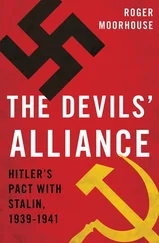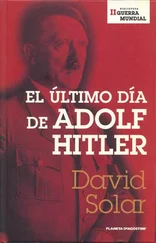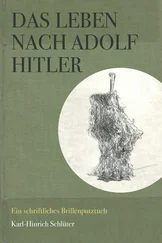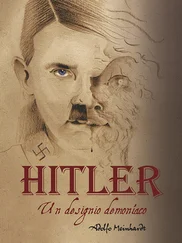Christa Schroeder - He Was My Chief - The Memoirs of Adolf Hitler's Secretary
Здесь есть возможность читать онлайн «Christa Schroeder - He Was My Chief - The Memoirs of Adolf Hitler's Secretary» весь текст электронной книги совершенно бесплатно (целиком полную версию без сокращений). В некоторых случаях можно слушать аудио, скачать через торрент в формате fb2 и присутствует краткое содержание. Город: Barnsley, Год выпуска: 2012, ISBN: 2012, Издательство: Frontline Books, Жанр: История, Биографии и Мемуары, на английском языке. Описание произведения, (предисловие) а так же отзывы посетителей доступны на портале библиотеки ЛибКат.
- Название:He Was My Chief: The Memoirs of Adolf Hitler's Secretary
- Автор:
- Издательство:Frontline Books
- Жанр:
- Год:2012
- Город:Barnsley
- ISBN:978-1-7830-3064-4
- Рейтинг книги:4 / 5. Голосов: 1
-
Избранное:Добавить в избранное
- Отзывы:
-
Ваша оценка:
- 80
- 1
- 2
- 3
- 4
- 5
He Was My Chief: The Memoirs of Adolf Hitler's Secretary: краткое содержание, описание и аннотация
Предлагаем к чтению аннотацию, описание, краткое содержание или предисловие (зависит от того, что написал сам автор книги «He Was My Chief: The Memoirs of Adolf Hitler's Secretary»). Если вы не нашли необходимую информацию о книге — напишите в комментариях, мы постараемся отыскать её.
He Was My Chief: The Memoirs of Adolf Hitler's Secretary — читать онлайн бесплатно полную книгу (весь текст) целиком
Ниже представлен текст книги, разбитый по страницам. Система сохранения места последней прочитанной страницы, позволяет с удобством читать онлайн бесплатно книгу «He Was My Chief: The Memoirs of Adolf Hitler's Secretary», без необходимости каждый раз заново искать на чём Вы остановились. Поставьте закладку, и сможете в любой момент перейти на страницу, на которой закончили чтение.
Интервал:
Закладка:
A day or so later Johanna Wolf went by car to Miesbach to ask friends if they would put us up temporarily. Two men from the SS-Hauptamt whom we had got to know at the Berghof mentioned the possibility of getting false papers for us, also possible lodgings. Meanwhile Schaub arrived and without a word set about clearing Hitler’s safe in the Führer-study. On the terrace of the Berghof he put a few cans of petrol to work burning letters, files, memoranda, books, etc. He only allowed a lad [141] This ’lad’ was actually thirty-year old SS-Untersturmführer Heinrich Doose (b. 1.7.1912 Kiel, d. 16.1.1952 Piding). From 1937 with the SS-Begleitkommando and Schaub’s driver; had previously been the driver for generals Burgdorf and Maisel and was present at the suicide of Rommel; on 21.4.1945 flew from Berlin to Ainring and brought Schaub from Hitler’s flat in Munich to the Berghof for the work of destruction; afterwards took Schaub’s family to Kitzbühl/Tirol; 2.6.1945 arrested by CIC at Berchtesgaden; 7.4.1948 released from internment.
from FHQ to help him; everybody else he deliberately ignored. He exchanged no pleasantries with us, no message from the boss, nothing of what was happening. Schaub’s bonfire below a leaden sky made a miserable impression.
When Schaub disappeared into the ruins of the Berghof for a brief while, I had a closer look at what he was burning. A shoebox filled with Geli Raubal’s correspondence caught my eye. Unfortunately I took only a single letter from the carefully assembled batch with male handwriting. It was however conclusive and set out clearly and distinctly the situation in which Geli had found herself. I also took a bundle of Hitler’s architectural plans, which I hid from Schaub and retained. A short distance away from the bonfire, where the compacted snow had heaped up against the terrace wall, was an A4-size binder burnt at the edges similar to an old-fashioned accounts ledger. It had a white label affixed to the cover with the typed title ‘Idea for and construction of the Greater German Reich’. Unfortunately I left this where it was.
Albert Bormann lived with his wife, who had given birth during the bombing raid, in the Berchtesgadener Hof, as did Schaub. They only came up to the Berghof to organise food and alcohol. Schaub also brought a friend, Hilde Marzelewski, a dancer from the Berlin ‘Metropol’. On 29 April it was announced in a radio broadcast that Hitler would not leave Berlin. At last it was clear to me that all was lost. Albert Bormann told the men of the SS-Begleitkommando , ‘Do not lose courage, it is not the end.’ I asked myself what else it could possibly be.
When Hitler’s death was announced on 1 May 1945 the change occurred in a manner scarcely to be described. Chaos broke out on the Obersalzberg. People from Berchtesgaden stormed the farm and cleared it, dragging off animals and breaking open stockpiles of potatoes. From the Bechsteinhaus, the former guest house for state visitors, and Speer’s house, the native population removed not only the articles which were easily transportable but also all the furniture. Nothing was left in the Platterhof hotel hairdresser’s shop.
In the cavernous Berghof bunkers where we were living strange women appeared, possibly friends of the Kripo officers, and made off with full containers. The police officers so previously devoted to law and order, the house staff and SS men of the Begleitkommando , all were suddenly transformed and unrecognisable. After clearing the Berghof kitchen of rubble, house administrator Mittelstrasser made off with a loaded lorry. His wife followed him a few days later after extensive packing. They were not heard from again. The cook Blüthgen, a previously demure young girl, had risen to absolute power. Previously clumsy and dim, she matured overnight. Negus, the Scotch terrier so adored by Eva Braun but loathed by everybody else because he growled at everybody and nibbled at their boots, slunk unnoticed and abandoned through the ruins. He had not been badly treated before, but now he was just another stray.
Negus was symbolic of the change that had come over the place; I felt alone and abandoned too, incapable of deciding my next move. The Pension Posthof at Hintersee near Berchtesgaden had long been reserved for employees and members of the adjutancy and Führer-household in Berlin. Food and drink were sent there for them. Albert Bormann had arranged rooms for Johanna Wolf and myself in this pension. He kept insisting that I should come at once, but I preferred to wait for Johanna first. Once the Americans began to close in he was suddenly of the opinion ‘that it was not good for everybody to be concentrated in one place. It would be better if everybody took it upon themselves to find their own accommodation.’ But where? I had neither the means to take off, nor anywhere to go after so many years cut off from the world in Hitler’s circle. So I stayed at the Berghof, living in the bunker.
The Berghof staff wanted to ship out the furniture and I contacted Albert Bormann at the Berchtesgadener Hof to obtain his agreement. [142] In her notes Schroeder wrote: ‘I obtained his permission that the girls should have some of the furniture. He had no idea what to do about the paintings. I was to give everybody a note of what I was taking and remove them myself.’
I also mentioned to him the intention of the Kripo ( Kriminalpolizei ) people to blow up the bunker rooms where Hitler’s private art collection was stored. Boxes of hand grenades were already placed at the bunker entrance. I considered it madness to destroy these valuable paintings. Albert Bormann was of the same opinion and agreed that everybody should take a picture with him. Meanwhile the Kripo officials had begun destroying everything they could lay their hands on in the bunkers. In Eva Braun’s bunker I surprised them smashing her valuable porcelain. These bore her insignia, painted by Sophie Stork, a monogram in the form of a four-leafed clover designed by Dr Karl Brandt. When I expressed my horror, they told me that ‘everything had to be destroyed which indicated the existence of Eva Braun’. What remained of her wardrobe, hats, dresses, shoes, etc., everything in fact which indicated a woman’s presence, was burnt on the terrace. Photo and film albums of Eva Braun with Hitler were senselessly cremated. The Kripo officials even ripped out the fly-leaf of any book with her name on it. It was pure madness, but apparently Schaub had the dead Hitler’s orders to go through with it. Even the valuable silver ware was to be destroyed, but here at least somebody saw sense and on 5 May an SS lorry arrived to cart away the silver, the carpets, tapestries and paintings.
It came about thus. That same evening Fegelein’s adjutant Hannes Göhler [143] Johannes Göhler, SS-Sturmbannführer from 21.12.1944.
suddenly appeared. I told him the story and expressed my disquiet. I mentioned that they were going to destroy all the paintings. He shared my opinion that it would be unforgivable and called up the lorry next morning to remove the paintings etc. to Fischhorn. I collected the most valuable pieces of artwork, Eva’s silver cutlery and sculptures and so forth in the bunker rooms and got the SS-Begleitkommando men to load them on the lorry. There were some very large paintings, including a Bordone and a Tintoretto, which were difficult to carry down the snowy southern slope now that the stairway to the road was unusable. The SS men were not slow to explain all the difficulties involved◦– so much for discipline! The lorry eventually arrived at Altaussee near Salzburg. Dr Emmerich Pöchmüller, during the Second World War director-general of the Austrian salt mines and charged with the safekeeping of art treasures, said some years later in a conversation with Henriette von Schirach: ‘At the last moment just before the Americans arrived, they sent me a part of Hitler’s private collection from the Obersalzberg!’ Amongst the invaluable treasures salted away at Altaussee since 1944 were those which Hitler had scheduled for the planned museum at Linz, mainly paintings by nineteenth-century German artists, but also very important works by Dutch, Italian and French painters, together with furniture, sculptures and artistic handicrafts.
Интервал:
Закладка:
Похожие книги на «He Was My Chief: The Memoirs of Adolf Hitler's Secretary»
Представляем Вашему вниманию похожие книги на «He Was My Chief: The Memoirs of Adolf Hitler's Secretary» списком для выбора. Мы отобрали схожую по названию и смыслу литературу в надежде предоставить читателям больше вариантов отыскать новые, интересные, ещё непрочитанные произведения.
Обсуждение, отзывы о книге «He Was My Chief: The Memoirs of Adolf Hitler's Secretary» и просто собственные мнения читателей. Оставьте ваши комментарии, напишите, что Вы думаете о произведении, его смысле или главных героях. Укажите что конкретно понравилось, а что нет, и почему Вы так считаете.












